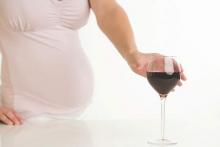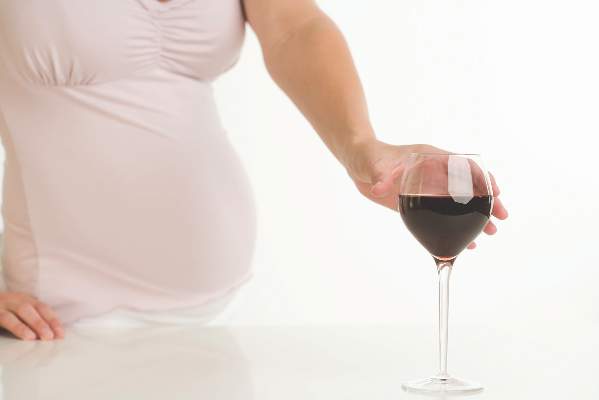User login
About 3% of pregnant women report binge drinking, according to data published in the Sept. 25 edition of the Morbidity and Mortality Weekly Report.
Cheryl H. Tan of the Centers for Disease Control and Prevention, Atlanta, and her colleagues analyzed data from the 2011-2013 Behavior Risk Factor Surveillance System (BRFSS) to understand the prevalence of binge drinking and any alcohol use in nonpregnant and pregnant women aged 18-44 years. The BRFSS is a telephone survey conducted with random-digit dialing to collect data on risk behaviors. The researchers analyzed data from 206,481 women, 8,383 of whom were pregnant at the time of the survey (MMWR. 2015;64[37]1042-6).
During the study period, there was a 10.2% prevalence of any alcohol use in pregnant women and a 3.1% prevalence of binge drinking (four or more drinks on one occasion, at least once in 30 days).
A higher prevalence of any alcohol consumption was reported in pregnant women aged 35-44 years (18.6%), those with a college degree (13%), and unmarried women (12.9%). Unmarried pregnant women had a prevalence of binge drinking 4.6 times the prevalence among married pregnant women.
Pregnant women who said they engaged in binge drinking reported more binge drinking episodes than did nonpregnant women (average of 4.6 episodes vs. 3.1; P = 0.044), despite an overall higher prevalence of binge drinking in nonpregnant women.
“One possible explanation for this might be that women who binge drink during pregnancy are more likely to be alcohol-dependent than the average female binge drinker, and therefore binge drink more frequently,” the researchers wrote.
Among the nonpregnant survey respondents, the prevalence of binge drinking was 18.2%, with 53.6% reporting any alcohol use. Nonpregnant women aged 18-20 years who reported binge drinking had the highest intensity with 7.1 drinks and the highest frequency with 3.9 episodes of binge drinking.
The authors noted several limitations of the study, including possible underreporting of pregnancy status because of unknown pregnancy, underreporting of alcohol use in self-reported surveys, and possible selection bias based on a response rate of less than 50%. Also, the method of collecting data for the BRFSS was changed in 2011, which limited the ability to compare the current data with earlier data.
“Healthcare professionals can support these efforts by implementing alcohol screening and brief interventions in their primary care practices, and informing women that there is no known safe level of alcohol consumption when they are pregnant or might be pregnant,” the researchers wrote.
About 3% of pregnant women report binge drinking, according to data published in the Sept. 25 edition of the Morbidity and Mortality Weekly Report.
Cheryl H. Tan of the Centers for Disease Control and Prevention, Atlanta, and her colleagues analyzed data from the 2011-2013 Behavior Risk Factor Surveillance System (BRFSS) to understand the prevalence of binge drinking and any alcohol use in nonpregnant and pregnant women aged 18-44 years. The BRFSS is a telephone survey conducted with random-digit dialing to collect data on risk behaviors. The researchers analyzed data from 206,481 women, 8,383 of whom were pregnant at the time of the survey (MMWR. 2015;64[37]1042-6).
During the study period, there was a 10.2% prevalence of any alcohol use in pregnant women and a 3.1% prevalence of binge drinking (four or more drinks on one occasion, at least once in 30 days).
A higher prevalence of any alcohol consumption was reported in pregnant women aged 35-44 years (18.6%), those with a college degree (13%), and unmarried women (12.9%). Unmarried pregnant women had a prevalence of binge drinking 4.6 times the prevalence among married pregnant women.
Pregnant women who said they engaged in binge drinking reported more binge drinking episodes than did nonpregnant women (average of 4.6 episodes vs. 3.1; P = 0.044), despite an overall higher prevalence of binge drinking in nonpregnant women.
“One possible explanation for this might be that women who binge drink during pregnancy are more likely to be alcohol-dependent than the average female binge drinker, and therefore binge drink more frequently,” the researchers wrote.
Among the nonpregnant survey respondents, the prevalence of binge drinking was 18.2%, with 53.6% reporting any alcohol use. Nonpregnant women aged 18-20 years who reported binge drinking had the highest intensity with 7.1 drinks and the highest frequency with 3.9 episodes of binge drinking.
The authors noted several limitations of the study, including possible underreporting of pregnancy status because of unknown pregnancy, underreporting of alcohol use in self-reported surveys, and possible selection bias based on a response rate of less than 50%. Also, the method of collecting data for the BRFSS was changed in 2011, which limited the ability to compare the current data with earlier data.
“Healthcare professionals can support these efforts by implementing alcohol screening and brief interventions in their primary care practices, and informing women that there is no known safe level of alcohol consumption when they are pregnant or might be pregnant,” the researchers wrote.
About 3% of pregnant women report binge drinking, according to data published in the Sept. 25 edition of the Morbidity and Mortality Weekly Report.
Cheryl H. Tan of the Centers for Disease Control and Prevention, Atlanta, and her colleagues analyzed data from the 2011-2013 Behavior Risk Factor Surveillance System (BRFSS) to understand the prevalence of binge drinking and any alcohol use in nonpregnant and pregnant women aged 18-44 years. The BRFSS is a telephone survey conducted with random-digit dialing to collect data on risk behaviors. The researchers analyzed data from 206,481 women, 8,383 of whom were pregnant at the time of the survey (MMWR. 2015;64[37]1042-6).
During the study period, there was a 10.2% prevalence of any alcohol use in pregnant women and a 3.1% prevalence of binge drinking (four or more drinks on one occasion, at least once in 30 days).
A higher prevalence of any alcohol consumption was reported in pregnant women aged 35-44 years (18.6%), those with a college degree (13%), and unmarried women (12.9%). Unmarried pregnant women had a prevalence of binge drinking 4.6 times the prevalence among married pregnant women.
Pregnant women who said they engaged in binge drinking reported more binge drinking episodes than did nonpregnant women (average of 4.6 episodes vs. 3.1; P = 0.044), despite an overall higher prevalence of binge drinking in nonpregnant women.
“One possible explanation for this might be that women who binge drink during pregnancy are more likely to be alcohol-dependent than the average female binge drinker, and therefore binge drink more frequently,” the researchers wrote.
Among the nonpregnant survey respondents, the prevalence of binge drinking was 18.2%, with 53.6% reporting any alcohol use. Nonpregnant women aged 18-20 years who reported binge drinking had the highest intensity with 7.1 drinks and the highest frequency with 3.9 episodes of binge drinking.
The authors noted several limitations of the study, including possible underreporting of pregnancy status because of unknown pregnancy, underreporting of alcohol use in self-reported surveys, and possible selection bias based on a response rate of less than 50%. Also, the method of collecting data for the BRFSS was changed in 2011, which limited the ability to compare the current data with earlier data.
“Healthcare professionals can support these efforts by implementing alcohol screening and brief interventions in their primary care practices, and informing women that there is no known safe level of alcohol consumption when they are pregnant or might be pregnant,” the researchers wrote.
FROM MMWR

